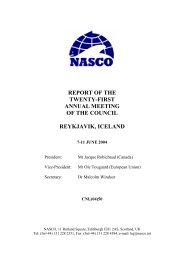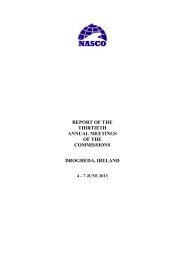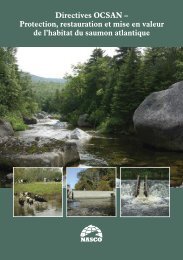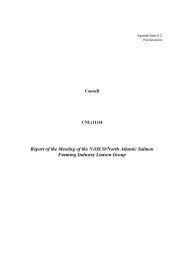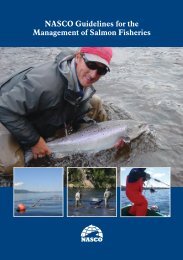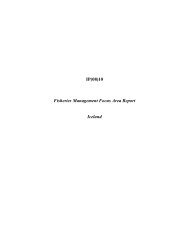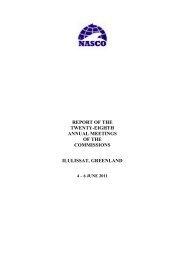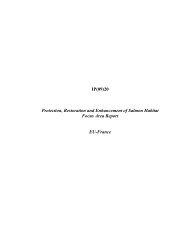Report of the 2005 ICES/NASCO Symposium on Interactions ...
Report of the 2005 ICES/NASCO Symposium on Interactions ...
Report of the 2005 ICES/NASCO Symposium on Interactions ...
Create successful ePaper yourself
Turn your PDF publications into a flip-book with our unique Google optimized e-Paper software.
NINA SPECIAL REPORT 34<br />
being framed in terms <str<strong>on</strong>g>of</str<strong>on</strong>g> probability <str<strong>on</strong>g>of</str<strong>on</strong>g> achieving preagreed<br />
management objectives. With many salm<strong>on</strong> stocks<br />
around <str<strong>on</strong>g>the</str<strong>on</strong>g> North Atlantic presently outside<br />
precauti<strong>on</strong>ary limits, and in some cases threatened or<br />
endangered, managers are beginning to place emphasis <strong>on</strong><br />
seeking catch advice in terms <str<strong>on</strong>g>of</str<strong>on</strong>g> rebuilding objectives for<br />
particular stocks or groups <str<strong>on</strong>g>of</str<strong>on</strong>g> stocks.<br />
Cultured Atlantic salm<strong>on</strong> in nature: review<br />
<str<strong>on</strong>g>of</str<strong>on</strong>g> ecology and interacti<strong>on</strong>s with wild fish<br />
Bror J<strong>on</strong>ss<strong>on</strong> and Nina J<strong>on</strong>ss<strong>on</strong><br />
Hatchery-raised Atlantic salm<strong>on</strong> released in nature<br />
compete with wild fish for food, space and breeding<br />
partners. Their competitive ability differs from that <str<strong>on</strong>g>of</str<strong>on</strong>g> wild<br />
fish owing to morphological, physiological, ecological and<br />
behavioural changes which occur in hatcheries.The change<br />
is partly phenotypic, partly genetic. The faster growth rate<br />
<str<strong>on</strong>g>of</str<strong>on</strong>g> hatchery juveniles influences age and size at smolting<br />
and maturity, reproductive output and l<strong>on</strong>gevity. Fastgrowing<br />
parr tend to smolt younger, produce more but<br />
smaller eggs, and attain maturity and die younger. Juvenile<br />
learning influences a number <str<strong>on</strong>g>of</str<strong>on</strong>g> behavioural traits, and<br />
differences in early experience appear to affect feeding<br />
and spawning success, migratory behaviour and homing<br />
ability. The genetic change is chiefly due to natural<br />
selecti<strong>on</strong> in hatcheries with differential mortality am<strong>on</strong>g<br />
genotypes, and brood stock selecti<strong>on</strong> based <strong>on</strong><br />
producti<strong>on</strong> traits such as large adult body mass and fast<br />
growth rate. Due to higher aggressi<strong>on</strong>, experimental<br />
evidence has revealed that hatchery parr <str<strong>on</strong>g>of</str<strong>on</strong>g>ten dominate<br />
wild parr, but hatchery parr can be subordinate if smaller,<br />
when <str<strong>on</strong>g>the</str<strong>on</strong>g>y co-occur in fast-flowing water and when wild<br />
smolts have prior residence. During spawning, <str<strong>on</strong>g>the</str<strong>on</strong>g> fitness<br />
<str<strong>on</strong>g>of</str<strong>on</strong>g> wild salm<strong>on</strong> is higher than that <str<strong>on</strong>g>of</str<strong>on</strong>g> hatchery-reared<br />
c<strong>on</strong>specifics. Hatchery males do poorly in intra-sexual<br />
competiti<strong>on</strong>, courting and spawning, and hatchery females<br />
have higher egg retenti<strong>on</strong>, c<strong>on</strong>struct fewer nests, and are<br />
less efficient in covering <str<strong>on</strong>g>of</str<strong>on</strong>g> <str<strong>on</strong>g>the</str<strong>on</strong>g> eggs in <str<strong>on</strong>g>the</str<strong>on</strong>g> bottom<br />
substratum. In rivers, early survival <str<strong>on</strong>g>of</str<strong>on</strong>g> hatchery <str<strong>on</strong>g>of</str<strong>on</strong>g>fspring is<br />
reduced compared with <str<strong>on</strong>g>the</str<strong>on</strong>g>ir wild counterparts.<br />
Experimentally, it has been found that <str<strong>on</strong>g>the</str<strong>on</strong>g> life-time<br />
reproductive success <str<strong>on</strong>g>of</str<strong>on</strong>g> farmed fish is <strong>on</strong>ly 1/6 <str<strong>on</strong>g>of</str<strong>on</strong>g> that <str<strong>on</strong>g>of</str<strong>on</strong>g><br />
similar-sized wild salm<strong>on</strong>. As a result <str<strong>on</strong>g>of</str<strong>on</strong>g> ecological<br />
interacti<strong>on</strong>s, hatchery fish may partly displace, increase <str<strong>on</strong>g>the</str<strong>on</strong>g><br />
mortality and decrease <str<strong>on</strong>g>the</str<strong>on</strong>g> growth rate, adult size,<br />
reproductive output, biomass and producti<strong>on</strong> <str<strong>on</strong>g>of</str<strong>on</strong>g> wild<br />
c<strong>on</strong>specifics through density-dependent mechanisms.<br />
Genetic and Ecological Interacti<strong>on</strong>s and<br />
Their Management<br />
Genetic and ecological interacti<strong>on</strong>s between<br />
wild and cultured diadromous fish<br />
Kjetil Hindar, Ian A Fleming, Phillip McGinnity and Ola Diserud<br />
Cultured salm<strong>on</strong>ids are released in large numbers, ei<str<strong>on</strong>g>the</str<strong>on</strong>g>r<br />
intenti<strong>on</strong>ally or accidentally, and make up significant<br />
proporti<strong>on</strong>s <str<strong>on</strong>g>of</str<strong>on</strong>g> salm<strong>on</strong>id populati<strong>on</strong>s in fresh and salt<br />
water. This causes c<strong>on</strong>siderable c<strong>on</strong>cern, because<br />
interacti<strong>on</strong>s between cultured fish and wild fish can<br />
reduce <str<strong>on</strong>g>the</str<strong>on</strong>g> fitness and productivity <str<strong>on</strong>g>of</str<strong>on</strong>g> wild populati<strong>on</strong>s.<br />
The interacti<strong>on</strong>s must be understood both within <str<strong>on</strong>g>the</str<strong>on</strong>g><br />
species’ range and outside it, as salm<strong>on</strong> aquaculture is a<br />
worldwide enterprise. This paper reviews genetic and<br />
ecological interacti<strong>on</strong>s between wild and cultured<br />
diadromous fish, focusing <strong>on</strong> <str<strong>on</strong>g>the</str<strong>on</strong>g> effects <str<strong>on</strong>g>of</str<strong>on</strong>g> farm Atlantic<br />
salm<strong>on</strong> (Salmo salar) <strong>on</strong> wild salm<strong>on</strong>. Farm salm<strong>on</strong> have<br />
been under artificial selecti<strong>on</strong> for growth and o<str<strong>on</strong>g>the</str<strong>on</strong>g>r<br />
ec<strong>on</strong>omically important traits for 30 years, and are<br />
genetically different from <str<strong>on</strong>g>the</str<strong>on</strong>g>ir origin at <str<strong>on</strong>g>the</str<strong>on</strong>g> molecular and<br />
quantitative genetic level. Escaped farm salm<strong>on</strong> spawn in<br />
<str<strong>on</strong>g>the</str<strong>on</strong>g> wild with limited success. Their <str<strong>on</strong>g>of</str<strong>on</strong>g>fspring outgrow<br />
those <str<strong>on</strong>g>of</str<strong>on</strong>g> wild origin, but appear to suffer higher mortality.<br />
Crosses between farm and wild salm<strong>on</strong> show<br />
intermediate performance. Whole-river experiments in<br />
Ireland and Norway show that <str<strong>on</strong>g>the</str<strong>on</strong>g> lifetime success <str<strong>on</strong>g>of</str<strong>on</strong>g> farm<br />
salm<strong>on</strong> was reduced relative to wild salm<strong>on</strong>. The overall<br />
productivity also appeared depressed. Based <strong>on</strong> <str<strong>on</strong>g>the</str<strong>on</strong>g>se<br />
findings, we make model predicti<strong>on</strong>s about <str<strong>on</strong>g>the</str<strong>on</strong>g> future <str<strong>on</strong>g>of</str<strong>on</strong>g><br />
wild salm<strong>on</strong>id populati<strong>on</strong>s.<br />
Interacti<strong>on</strong>s between salm<strong>on</strong> farming and<br />
marine coastal ecosystems in <str<strong>on</strong>g>the</str<strong>on</strong>g> south-east<br />
Pacific<br />
Alejandro H Buschmann, Verónica A Riquelme, María C<br />
Hernández-G<strong>on</strong>zález, Daniel Varela, Jaime Jiménez, Luis A<br />
Henríquez, Pedro A Vergara, Ricardo Guiñez and Luis Filún<br />
Salm<strong>on</strong> aquaculture exportati<strong>on</strong> in Chile reached 311,000<br />
t<strong>on</strong>s in 2004, making it <str<strong>on</strong>g>the</str<strong>on</strong>g> sec<strong>on</strong>d-largest producer <str<strong>on</strong>g>of</str<strong>on</strong>g><br />
farmed salm<strong>on</strong> in <str<strong>on</strong>g>the</str<strong>on</strong>g> world behind Norway. Because <str<strong>on</strong>g>of</str<strong>on</strong>g><br />
this, <str<strong>on</strong>g>the</str<strong>on</strong>g> industry is now c<strong>on</strong>sidered as c<strong>on</strong>solidated but<br />
with fur<str<strong>on</strong>g>the</str<strong>on</strong>g>r potential expansi<strong>on</strong>. In order to keep <strong>on</strong><br />
growing, <str<strong>on</strong>g>the</str<strong>on</strong>g> salm<strong>on</strong> industry must expand its activities<br />
fur<str<strong>on</strong>g>the</str<strong>on</strong>g>r south and thus reach pristine areas with little<br />
human activity so far, resulting in increasing calls for<br />
c<strong>on</strong>servati<strong>on</strong> acti<strong>on</strong>s. Never<str<strong>on</strong>g>the</str<strong>on</strong>g>less, <str<strong>on</strong>g>the</str<strong>on</strong>g> envir<strong>on</strong>mental<br />
effects <str<strong>on</strong>g>of</str<strong>on</strong>g> salm<strong>on</strong> cultivati<strong>on</strong> in sou<str<strong>on</strong>g>the</str<strong>on</strong>g>rn Chile remain<br />
27



